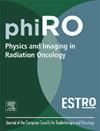锥束计算机断层扫描监测非小细胞肺癌放疗期间靶体积和危险器官剂量变化的时间序列分析
IF 3.3
Q2 ONCOLOGY
引用次数: 0
摘要
背景与目的放射治疗技术的进步提高了在保留正常组织的同时增加肿瘤剂量的能力。我们进行了时间序列聚类分析,以表征放射治疗期间剂量学的动态变化。材料和方法我们分析了40例非小细胞肺癌患者的剂量变化,这些患者每天接受60 Gy的锥束计算机断层扫描引导分数。计算危险器官(肺、心脏、脊髓和食道)、总肿瘤体积、临床靶体积(CTV)和计划靶体积与计划剂量在所有分数上的百分比偏差。采用动态时间翘曲距离的k均值聚类来确定时间剂量模式。选取方差最小的靶体积(CTV剂量覆盖率95% [CTVD95])作为参考。使用肘部法聚类OAR剂量偏差。平均时间趋势以95%的置信区间绘制。结果CTVD95在各部位、各患者均保持稳定,可作为时间序列聚类的参考。聚类1包括大多数患者,表现出低变异性和可预测的剂量轨迹,肺和食道剂量逐渐增加,心脏和脊髓剂量稳定。簇2表现出高分数间变异性,逐渐增加OAR剂量偏差。结论时间序列聚类可以早期识别出具有不同剂量演变模式的患者。集群1的稳定轨迹可以作为适应性放疗的内部参考。第2组的可变性强调需要进行常规剂量监测,以支持及时的离线适应。本文章由计算机程序翻译,如有差异,请以英文原文为准。

Time series analysis of dosimetric changes in target volumes and organs at risk monitored by cone beam computed tomography during radiotherapy for non-small-cell lung cancer
Background and Purpose
Technological advancements in radiotherapy have enhanced the ability to increase tumor doses while sparing normal tissues. We performed a time-series cluster analysis to characterize dynamic variations in dosimetry during radiotherapy.
Materials and Methods
We analyzed dosimetric variations of 40 patients with non-small-cell lung cancer who received 60 Gy over 30 daily cone beam computed tomography-guided fractions. Percentage deviations from planned doses across all fractions were calculated for organs at risk (OARs) (lungs, heart, spinal cord, and esophagus), gross tumor volume, clinical target volume (CTV), and planning target volume. K-means clustering with dynamic time-warping distances was applied to identify temporal dose patterns. The target volume with the lowest variance (95 % dose coverage of the CTV [CTVD95]) was selected as a reference. OAR dose deviations were clustered using the elbow method. Mean temporal trends were plotted with 95 % confidence intervals.
Results
The CTVD95 remained stable across all fractions and all patients and was used as a reference for time-series clustering. Cluster 1 included the majority of patients and exhibited low variability and predictable dose trajectories with gradual increases in the lung and esophagus doses and stable patterns in the heart and spinal cord. Cluster 2 showed high inter-fractional variability with progressively increasing OAR dose deviations.
Conclusions
Time-series clustering enabled early identification of patients with distinct dose evolution patterns. The stable trajectories of Cluster 1 may serve as internal references for adaptive radiotherapy. Variability in Cluster 2 underscores the need for routine dose monitoring to support timely offline adaptation.
求助全文
通过发布文献求助,成功后即可免费获取论文全文。
去求助
来源期刊

Physics and Imaging in Radiation Oncology
Physics and Astronomy-Radiation
CiteScore
5.30
自引率
18.90%
发文量
93
审稿时长
6 weeks
 求助内容:
求助内容: 应助结果提醒方式:
应助结果提醒方式:


